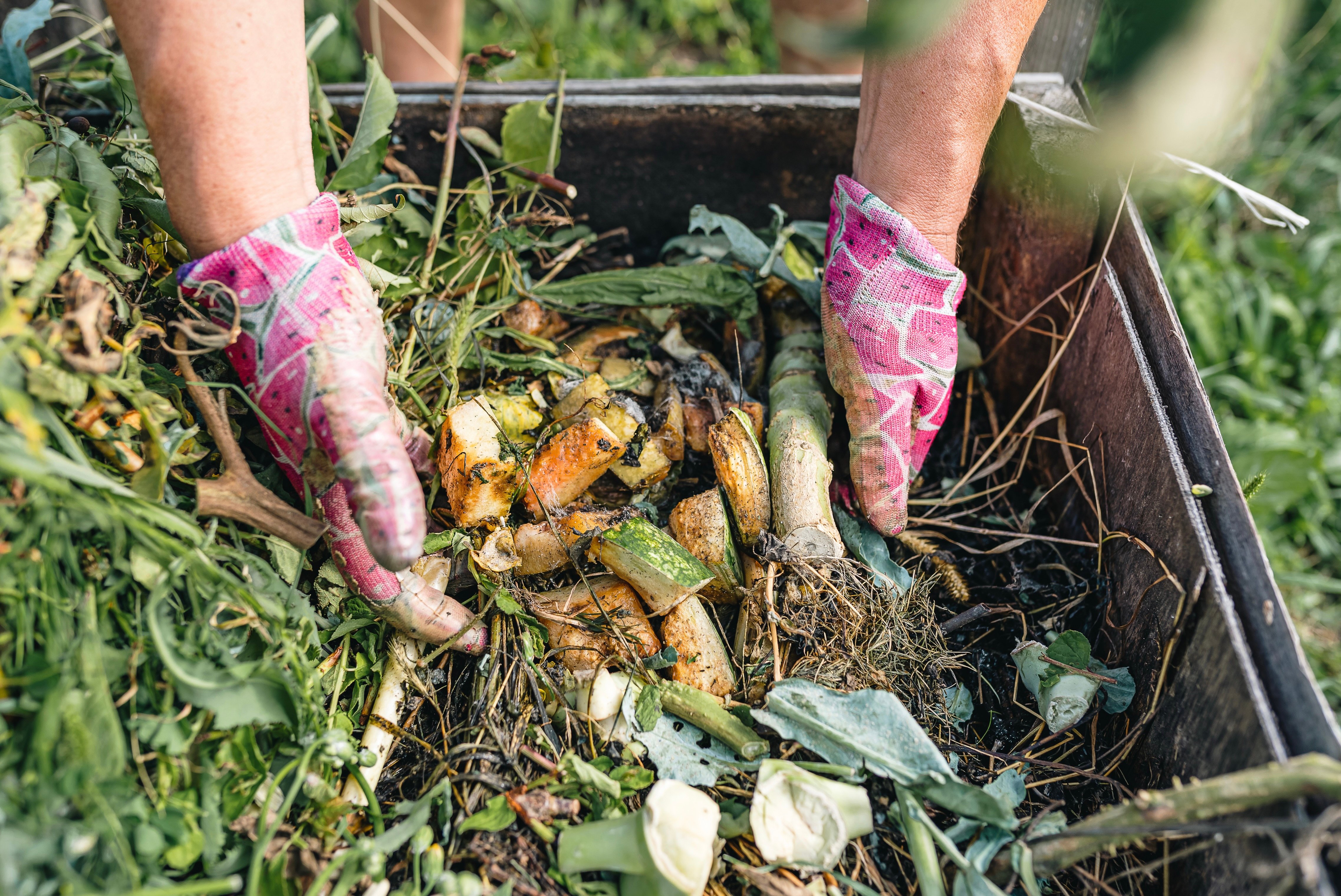What is Composting?
Composting is nature’s recycling program for your kitchen scraps and yard waste. It’s the process of turning things like fruit peels, vegetable scraps, coffee grounds, and leaves into a valuable resource called compost. Tiny creatures like worms, bugs, and fungi work together to break down this organic matter, creating a rich, dark soil that’s super healthy for plants. Home composting is a fantastic way to reduce your waste, help the environment, and save money by creating your own free fertilizer.
Backyard Composting
Composting in your backyard is an eco-friendly and rewarding way to recycle organic waste while enriching your soil. At its core, composting relies on a balanced mixture of nitrogen-rich materials “greens”, carbon-rich materials “browns,” water, and air. Understanding what to include and what to leave out will help ensure your compost pile thrives and your garden flourishes.
Some examples of materials you can add are:
Nitrogen-Rich Materials “greens”
- Fruit and Vegetable Scraps
- Coffee Grounds and Paper Filters
- Grass Clippings
- Eggshells and Nutshells
- Fruit Pits and Peels
- Livestock Manure
Carbon-Rich Materials “browns”
- Dry Leaves
- Plant Stalks and Twigs
- Shredded Brown Bags / Paper (non-glossy, uncolored)
- Shredded Cardboard (no tape or glue)
- Straw and Hay
To add air to the compost pile you need to turn it over with a fork or shovel every week. You can also stick branches or pipes into the pile to help with this. Add water as needed, especially after adding new layers. The pile should be moist, like a wrung-out sponge.
What to avoid adding to your compost pile:
- Meat, Fish, Bones
- Cheese and Dairy Products
- Fat, Oils, and Grease
- Herbicide-Treated Plants/Grass
- Pet Waste and Cat Litter
- Produce Stickers
- Treated or Painted Wood
- Glossy Paper
- Dryer Lint
Why do I need to avoid these items?
The reason is that these foods/materials can either attract animals or prevent the backyard composting piles from reaching the needed temperature to fully decompose these materials.
Step-by-Step Guide to Backyard Composting
1. Preparation
Collect and Store: You can store your greens (nitrogen-rich) such as fruit and vegetable scraps in a closed container on your kitchen counter, under the sink, or in the refrigerator. You can gather browns (carbon-rich) by collecting and storing dry leaves, twigs, and other suitable materials in a designated area.
Choose a Location: Select a suitable spot in your yard for your compost pile. The best location for composting is a dry, shady area. In rainy climates, avoid placing your compost pile or bin under eaves or in spots with poor drainage, as this can cause the compost to become too soggy. In sunny areas, choose a shaded spot to prevent the compost from drying out too quickly, reducing the need to constantly add water. Ensure it’s easily accessible, has good drainage, and is away from fences.
Select a Bin: Choose a composting bin that suits your needs and space. A closed compost bin helps keep your composting materials contained while retaining heat and moisture. These bins typically have an open bottom, and you place them directly on the soil. Common DIY options include wine crates, plastic storage bins, garbage cans, or wooden pallets.
Alternatively, you can use an open bin, such as a loop of chicken wire, which allows easy dumping of materials. This option tends to require less maintenance, however, it’s not as effective at keeping animals out.
Another choice is a tumbler bin, a sealed container mounted on an axle or base with a handle for easy rotation. Tumbler bins are available online or at most gardening stores, allowing you to turn the compost, create aeration, and mix the materials. This can accelerate the composting process by helping materials break down faster.
2. Building Your Compost Pile
Start with a Base: Begin with a layer of bulky browns (like twigs or wood chips) to absorb excess moisture and improve air circulation.
Layer Materials: Alternate layers of “greens” and browns”. Layering materials allows for proper airflow.
Add Moisture: Lightly dampen the pile with water. Aim for a consistency similar to a wrung-out sponge.
3. Maintaining Your Compost Pile
Proper Ratios: Maintain a balanced ratio of browns and greens.
Aeration: Regularly turn the pile using a garden fork to introduce air and speed up decomposition. The consistency depends on the individual preferences however, doing it more often can speed up the process.
Moisture Control: Monitor moisture levels. Too dry add water, if too wet, add more browns. Remember to aim for a “wrung-out sponge” consistency.
Temperature: As the materials start to compost pile begin to decompose, the temperature of the pill will rise, if well-maintained the pile can reach a temperature of 130 to 160F. High temperatures can reduce the presence of pathogens and weed seeds.
Troubleshooting:
Avoid Rodents!
If using a bin with a lid and potentially a floor. There should be no holes or gaps in your bin that are larger than ¼ inch. Ensure you cover and bury your food scraps in your pile. Do not add meat, dairy, or greasy foods to your pile.
Bad Odor?
If the pile smells unpleasant, it might be too wet or lack sufficient air circulation. Add more browns and turn the pile for more aeration or add more water to achieve a wrung-out consistency.
Slow Decomposition?
If the pile isn’t heating up, add more greens and turn it regularly.
4. Harvest your Finished Compost
Curing: Once the pile stops heating up and visible food scrapes are no longer present, allow the compost to cure for several weeks.
Screening: Screen the finished compost to remove any remaining large pieces.
Use: Enjoy your homemade compost to enrich your garden soil.
Composting is a natural process that takes time, so be patient and with a little time, care, and attention, you’ll be rewarded with rich, nutrient-packed compost that will make your garden grow stronger and healthier.
Community Composting: A Collective Effort for a Greener Future!
Not everyone has the space or resources for backyard composting, but that doesn’t mean you can’t still contribute to reducing waste and improving soil health. Community composting is an excellent alternative that brings neighbors and local organizations together to compost organic waste. In community composting programs, participants drop off their food scraps and yard waste at a central location where it is composted on a larger scale. These programs help reduce landfill waste, lower carbon footprints, and generate nutrient-rich compost that can be used in local gardens, parks, and farms.
Community composting offers several advantages:
- Convenience: Participants can drop off their scraps without needing to manage their own compost pile.
- Environmental Impact: By composting together, communities can divert significant amounts of waste from landfills and reduce greenhouse gas emissions.
- Education: Community composting programs often include educational resources, helping participants learn how to compost and why it’s important for the environment.
To get involved, check if your local community offers a composting program. Many municipalities and community centers have drop-off locations, or they might even offer composting bins for home use. It’s a simple and impactful way to participate in the circular economy while fostering a spirit of cooperation within your neighborhood.
Composting is a simple yet powerful way to minimize your environmental impact and create a valuable resource for your garden. Whether you choose the traditional backyard method, working with your community, or another approach – you’re contributing to a healthier planet and enjoying the satisfaction of creating nutrient-rich soil from your own kitchen scraps. By understanding the basic principles and following these guidelines, you can easily incorporate composting into your daily life and reap the rewards of a greener, more sustainable lifestyle.





Leave a Reply